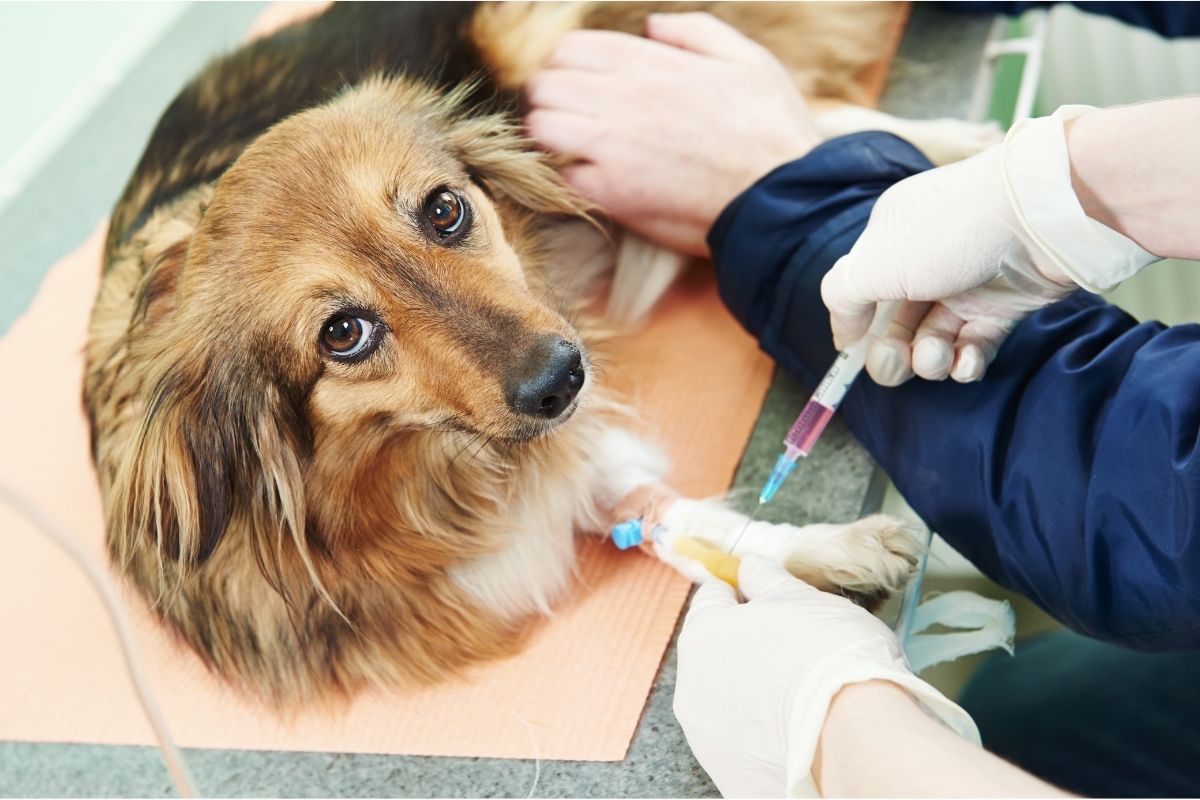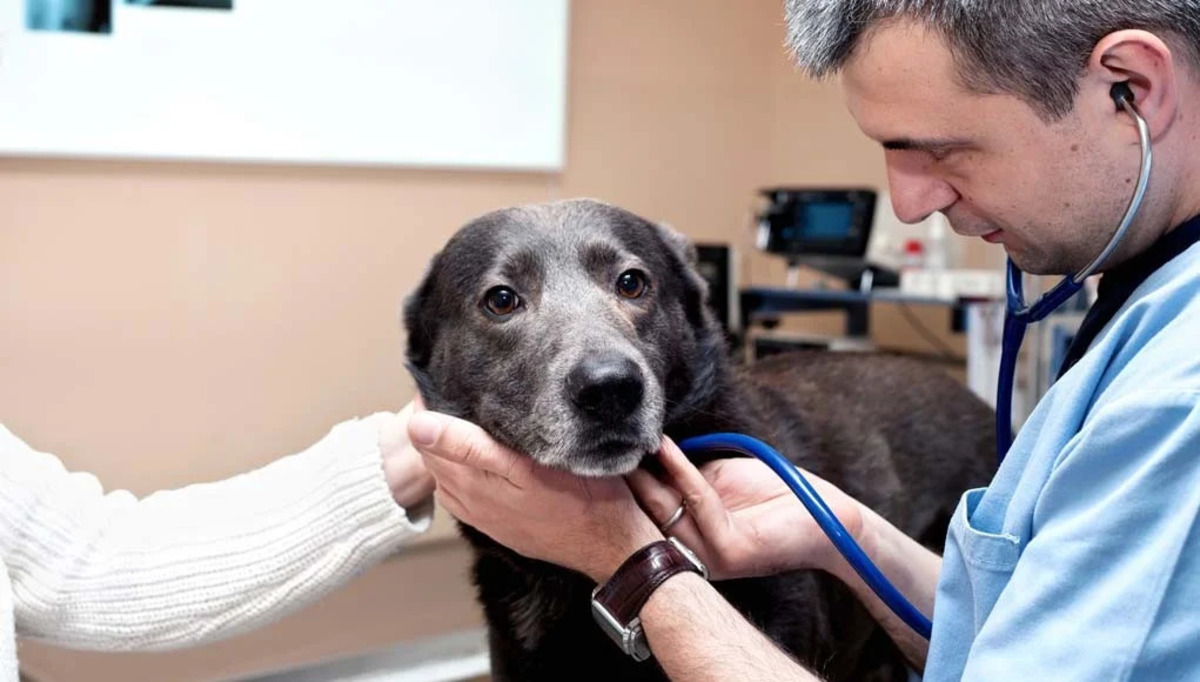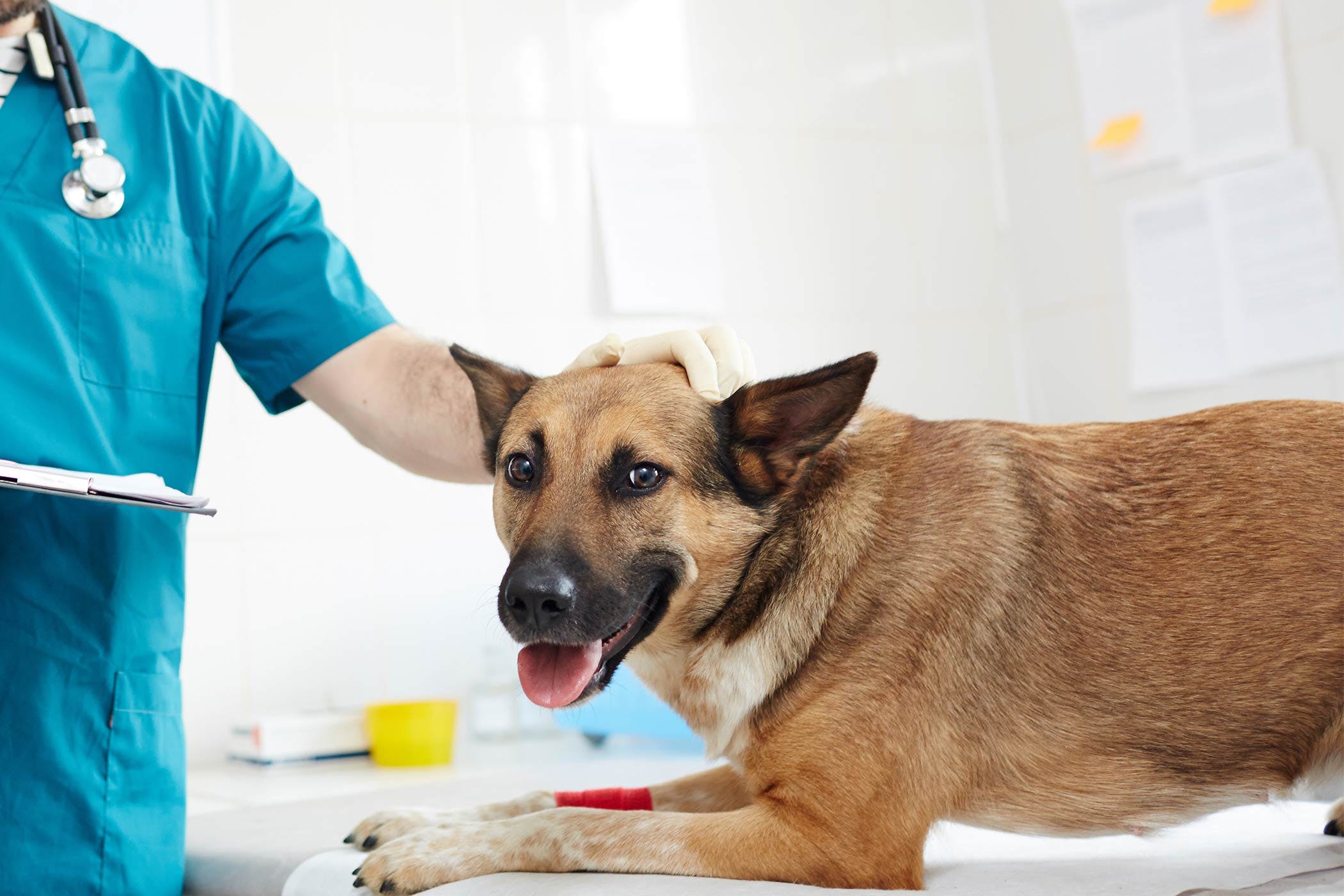Home>Health & Wellness>Common Health Issues>How Do You Test Dogs For Cancer


Common Health Issues
How Do You Test Dogs For Cancer
Published: February 4, 2024
Learn about common health issues in dogs and how to test for cancer. Discover the best methods for early detection and treatment options.
(Many of the links in this article redirect to a specific reviewed product. Your purchase of these products through affiliate links helps to generate commission for Pawsomeoldies.com, at no extra cost. Learn more)
Table of Contents
Introduction
Cancer is a formidable adversary, not only for humans but also for our beloved canine companions. Just like in humans, cancer in dogs can manifest in various forms and affect different parts of their bodies. As responsible pet owners, it's crucial to be aware of the signs and symptoms of cancer in dogs, as early detection can significantly impact the prognosis and treatment options available.
Understanding how cancer can affect dogs and the diagnostic tests and treatment options available is essential for providing the best possible care for our furry friends. In this article, we will delve into the types of cancer that commonly affect dogs, the symptoms to watch out for, and the diagnostic tests used to detect cancer in dogs. Additionally, we will explore the available treatment options and the importance of early intervention in managing cancer in dogs.
By gaining insight into these crucial aspects, we can equip ourselves with the knowledge needed to recognize potential warning signs and take proactive measures to ensure the well-being of our canine companions. Let's embark on this informative journey to understand how cancer can impact dogs and the steps we can take to support their health and happiness.
Read more: How Do You Test For Heartworm In A Dog
Types of Cancer in Dogs
Cancer can affect dogs in various ways, with different types of cancer targeting specific areas of their bodies. Understanding the different types of cancer that commonly afflict dogs is crucial for early detection and effective management. Here are some of the most prevalent types of cancer seen in dogs:
1. Lymphoma
Lymphoma is one of the most common types of cancer in dogs, affecting the lymphatic system. This cancer originates in the lymphocytes, which are a type of white blood cell. Dogs with lymphoma may exhibit symptoms such as swollen lymph nodes, lethargy, decreased appetite, and weight loss.
2. Mast Cell Tumors
Mast cell tumors are a type of skin cancer that can occur in dogs. These tumors originate from a type of white blood cell and can vary in size and appearance. Symptoms of mast cell tumors may include skin lumps or masses, itching, redness, and ulceration at the tumor site.
3. Osteosarcoma
Osteosarcoma is a bone cancer that commonly affects large and giant dog breeds. This aggressive cancer can cause lameness, swelling, and pain in the affected limb. Osteosarcoma is known for its rapid progression and tendency to metastasize to other parts of the body.
Read more: How Much Is A Dog Eye Test At A Vet?
4. Hemangiosarcoma
Hemangiosarcoma is a highly malignant cancer that originates in the blood vessels. It often affects the spleen, liver, or heart in dogs. Symptoms of hemangiosarcoma may include weakness, collapse, pale mucous membranes, and abdominal distension due to internal bleeding.
5. Mammary Gland Tumors
Mammary gland tumors are common in female dogs that have not been spayed. These tumors can be benign or malignant and are often detected as lumps or masses in the mammary glands. Early spaying can significantly reduce the risk of developing mammary gland tumors in female dogs.
6. Melanoma
Melanoma is a type of skin cancer that can affect dogs, often appearing as dark pigmented masses on the skin or in the mouth. Oral melanoma is particularly aggressive and can quickly spread to other parts of the body.
Understanding the various types of cancer that can affect dogs is essential for pet owners and veterinarians alike. By recognizing the specific characteristics and symptoms associated with each type of cancer, early intervention and appropriate treatment strategies can be implemented to improve the prognosis and quality of life for dogs diagnosed with cancer.
Symptoms of Cancer in Dogs
Recognizing the potential symptoms of cancer in dogs is crucial for early detection and prompt intervention. While the signs of cancer can vary depending on the type and location of the tumor, there are several common symptoms that pet owners should be vigilant about.
-
Unexplained Weight Loss: Sudden and unexplained weight loss in dogs can be a red flag for various underlying health issues, including cancer. If a dog experiences significant weight loss without a change in diet or exercise routine, it warrants a thorough veterinary evaluation.
-
Lumps and Swellings: Palpable lumps or swellings on the body, especially in the lymph nodes, mammary glands, or skin, should be promptly examined by a veterinarian. While not all lumps are cancerous, any new or rapidly growing masses should be investigated to rule out malignancy.
-
Persistent Lethargy: Dogs are typically active and energetic animals. Persistent lethargy, unexplained fatigue, or a noticeable decrease in activity levels can be indicative of an underlying health issue, including cancer.
-
Changes in Appetite: A sudden loss of appetite or a significant decrease in food consumption can be a sign of various health problems, including cancer. Conversely, increased hunger or unexplained changes in eating habits should also be monitored closely.
-
Difficulty Breathing: Respiratory distress, labored breathing, or persistent coughing can be symptoms of certain types of cancer, particularly those affecting the lungs or respiratory system.
-
Abnormal Bleeding: Unexplained bleeding from the nose, mouth, or other bodily orifices should never be ignored. It can be a symptom of various health conditions, including cancer, and requires immediate veterinary attention.
-
Persistent Lameness or Pain: Dogs experiencing persistent lameness, difficulty in movement, or unexplained pain, especially in the bones or joints, should be evaluated for potential musculoskeletal cancers such as osteosarcoma.
-
Changes in Bathroom Habits: Any noticeable changes in a dog's urinary or bowel habits, such as difficulty urinating, blood in the urine or stool, or sudden incontinence, should be investigated promptly.
-
Visible Wounds That Don't Heal: Wounds or sores that do not heal or show signs of persistent inflammation can be indicative of underlying health issues, including certain types of skin cancer.
-
Neurological Symptoms: Seizures, unexplained behavior changes, disorientation, or other neurological symptoms can be associated with brain tumors or other central nervous system cancers.
It's important to note that while these symptoms can be indicative of cancer, they can also be caused by other health conditions. Therefore, if a dog exhibits any of these signs, it is essential to seek prompt veterinary care for a comprehensive evaluation and diagnosis.
By being attentive to these potential symptoms and seeking timely veterinary care, pet owners can play a proactive role in ensuring the early detection and effective management of cancer in their canine companions. This vigilance can significantly impact the prognosis and treatment outcomes for dogs diagnosed with cancer.
Read more: How Do Dogs Get Bladder Cancer
Diagnostic Tests for Cancer in Dogs
When cancer is suspected in a dog, accurate and timely diagnosis is essential for determining the type and extent of the disease, as well as for formulating an appropriate treatment plan. Veterinary professionals employ a range of diagnostic tests to evaluate and confirm the presence of cancer in dogs. These tests are instrumental in providing valuable insights into the nature of the disease, guiding treatment decisions, and offering prognostic information. Here are the primary diagnostic tests used for detecting cancer in dogs:
Blood Tests for Cancer in Dogs
Blood tests, including complete blood count (CBC) and serum chemistry panels, play a crucial role in the initial assessment of a dog's health and can provide valuable indicators of underlying disease processes. In cases of suspected cancer, blood tests may reveal abnormalities such as anemia, changes in white blood cell counts, or alterations in specific biochemical markers that can raise suspicion of cancer. Additionally, specialized blood tests, such as tests for specific tumor markers, may be employed to aid in the diagnosis of certain types of cancer.
Imaging Tests for Cancer in Dogs
Imaging modalities, including X-rays, ultrasound, and advanced imaging techniques such as computed tomography (CT) and magnetic resonance imaging (MRI), are invaluable tools for visualizing internal structures and detecting abnormalities indicative of cancer. These tests can help identify the presence of tumors, assess their size and location, and evaluate potential metastasis to other organs or tissues. Imaging tests are particularly useful for diagnosing cancers affecting the bones, internal organs, and soft tissues.
Biopsy and Cytology Tests for Cancer in Dogs
Biopsy and cytology are definitive diagnostic procedures that involve the collection and examination of tissue or cellular samples to determine the presence of cancerous cells. Biopsies may be performed through surgical excision of a tumor or through minimally invasive techniques such as fine needle aspiration. Cytology, which involves the evaluation of cells obtained from body fluids or tissue samples, can provide rapid insights into the nature of a tumor, aiding in the identification of cancerous cells and the classification of the cancer type.
These diagnostic tests, in combination with a thorough physical examination and a comprehensive medical history, form the cornerstone of cancer diagnosis in dogs. The results of these tests enable veterinarians to establish an accurate diagnosis, devise tailored treatment plans, and provide pet owners with essential information about the prognosis and management of their dog's cancer.
By leveraging these diagnostic tools, veterinary professionals can make informed decisions regarding the most appropriate treatment strategies, including surgery, chemotherapy, radiation therapy, or palliative care, tailored to the specific needs of the individual dog. Early and accurate diagnosis through these diagnostic tests is pivotal in ensuring the best possible outcomes for dogs facing a cancer diagnosis.
Blood Tests for Cancer in Dogs
Blood tests are an integral component of the diagnostic process when cancer is suspected in dogs. These tests provide valuable insights into the overall health status of the canine patient and can offer important indicators of underlying disease processes, including the presence of cancer. When evaluating a dog for potential cancer, veterinarians may utilize a range of blood tests to assess various parameters and identify potential abnormalities that warrant further investigation.
One of the primary blood tests employed in the assessment of dogs suspected of having cancer is the complete blood count (CBC). This test provides detailed information about the cellular components of the blood, including red blood cells, white blood cells, and platelets. An abnormal CBC can raise suspicion of an underlying disease, including certain types of cancer. For example, anemia, which is characterized by a low red blood cell count, can be indicative of conditions such as hemangiosarcoma or bone marrow disorders. Conversely, an elevated white blood cell count may suggest an inflammatory response or the presence of certain types of cancer, such as leukemia.
In addition to the CBC, serum chemistry panels are commonly utilized to assess the biochemical components of the blood. These panels provide information about organ function, electrolyte balance, and metabolic parameters. In cases of suspected cancer, serum chemistry panels can reveal abnormalities that may be associated with specific types of cancer. For instance, liver enzymes may be elevated in the presence of liver tumors, while alterations in kidney function parameters can be indicative of renal cancer or metastasis to the kidneys.
Furthermore, specialized blood tests designed to detect specific tumor markers or antigens may be employed in the diagnostic workup for certain types of cancer. These tests are aimed at identifying the presence of specific substances that are produced by cancer cells or released into the bloodstream in response to the presence of a tumor. For example, elevated levels of alkaline phosphatase may be indicative of bone cancer, while elevated levels of prostate-specific antigen (PSA) can be associated with prostatic tumors.
Overall, blood tests play a crucial role in the initial assessment of dogs suspected of having cancer. They provide valuable indicators of underlying disease processes, guide further diagnostic investigations, and contribute to the formulation of an accurate diagnosis. By leveraging the information obtained from blood tests, veterinarians can make informed decisions regarding the most appropriate diagnostic and treatment strategies for dogs facing a potential cancer diagnosis.
Imaging Tests for Cancer in Dogs
Imaging tests play a pivotal role in the diagnostic process for identifying and evaluating cancer in dogs. These non-invasive techniques provide invaluable insights into the internal structures of the canine body, aiding in the detection, localization, and characterization of tumors. By visualizing anatomical abnormalities and potential metastatic spread, imaging tests are instrumental in guiding treatment decisions and prognostic assessments for dogs suspected of having cancer.
X-rays
X-rays, also known as radiographs, are commonly employed in the initial evaluation of dogs with suspected cancer. They provide detailed images of the skeletal system and can detect abnormalities such as bone lesions, fractures, and the presence of tumors within the bones. Additionally, chest X-rays are crucial for evaluating the lungs and detecting potential metastases from primary tumors in other parts of the body. X-rays are particularly useful for diagnosing bone cancers, such as osteosarcoma, and assessing the extent of pulmonary metastasis.
Ultrasound
Ultrasound imaging utilizes sound waves to create real-time images of internal organs and soft tissues. This modality is valuable for evaluating abdominal organs, detecting masses within the liver, spleen, and other visceral structures, and assessing the presence of tumors in the gastrointestinal tract. Additionally, ultrasound can aid in the visualization of tumors within the urinary bladder, reproductive organs, and soft tissue structures. It is a non-invasive and well-tolerated imaging technique that provides detailed anatomical information without the need for anesthesia in most cases.
Read more: How Often Do Dogs Get Testicular Cancer
Computed Tomography (CT)
CT scans utilize advanced X-ray technology to create detailed cross-sectional images of the body. This imaging modality is particularly useful for visualizing complex anatomical structures, identifying tumors in the brain, thorax, and abdomen, and assessing the extent of soft tissue masses. CT scans provide high-resolution images that enable precise localization and characterization of tumors, making them an essential tool for treatment planning and surgical interventions. Additionally, CT imaging is instrumental in detecting metastatic spread to lymph nodes and distant organs, aiding in the staging of cancer in dogs.
Magnetic Resonance Imaging (MRI)
MRI is a sophisticated imaging technique that utilizes powerful magnets and radio waves to generate detailed images of soft tissues, organs, and the central nervous system. It is particularly valuable for visualizing brain tumors, spinal cord lesions, and soft tissue masses that may not be clearly delineated on other imaging modalities. MRI provides exceptional contrast resolution and is essential for evaluating tumors in sensitive anatomical locations, guiding neurosurgical interventions, and assessing the extent of intracranial and spinal neoplasms.
In summary, imaging tests, including X-rays, ultrasound, CT scans, and MRI, are essential components of the diagnostic workup for cancer in dogs. These modalities provide comprehensive anatomical information, aid in tumor localization and characterization, and contribute to the staging and treatment planning for dogs diagnosed with cancer. By leveraging the insights obtained from imaging tests, veterinarians can make informed decisions regarding the most appropriate treatment strategies, including surgery, radiation therapy, and chemotherapy, tailored to the specific needs of the individual canine patient.
Biopsy and Cytology Tests for Cancer in Dogs
Biopsy and cytology tests are fundamental diagnostic procedures used to definitively identify and characterize cancer in dogs. These tests involve the collection and examination of tissue or cellular samples, providing crucial insights into the nature of tumors and facilitating accurate cancer diagnosis.
Biopsy
Biopsy procedures entail the surgical removal of a sample of tissue from a suspected tumor or abnormal growth. This tissue sample is then examined under a microscope by a veterinary pathologist to determine the presence of cancerous cells and ascertain the specific type of cancer. Biopsies can be performed through various methods, including excisional biopsy, incisional biopsy, and needle biopsy. Excisional biopsies involve the complete removal of the tumor, providing a definitive diagnosis and often serving as a therapeutic intervention. Incisional biopsies involve the partial removal of the tumor, while needle biopsies utilize a fine needle to extract tissue samples from the tumor site. The type of biopsy performed depends on the size, location, and characteristics of the tumor.
Cytology
Cytology, or fine needle aspiration (FNA), is a minimally invasive technique used to obtain cellular samples from tumors or abnormal masses. During FNA, a thin needle is inserted into the tumor, and cells are aspirated for microscopic examination. Cytology is particularly useful for evaluating superficial masses, lymph nodes, and organs accessible by ultrasound guidance. The obtained cellular samples are then analyzed to identify the presence of cancerous cells, assess the tumor's characteristics, and determine the degree of malignancy. Cytology is a valuable tool for rapid preliminary diagnosis, aiding in the formulation of treatment plans and guiding further diagnostic investigations.
Both biopsy and cytology tests play critical roles in the diagnostic process for cancer in dogs. They provide essential information about the nature of tumors, including their histological type, grade, and potential for metastasis. The results of these tests are instrumental in guiding treatment decisions, determining the prognosis, and formulating tailored therapeutic strategies for dogs diagnosed with cancer. By leveraging the insights obtained from biopsy and cytology tests, veterinarians can offer personalized care and optimize the management of cancer in canine patients, ultimately striving to improve their quality of life and long-term outcomes.
Treatment Options for Cancer in Dogs
The treatment of cancer in dogs encompasses a multifaceted approach aimed at addressing the specific type of cancer, its stage, and the individual patient's overall health and well-being. Veterinary oncologists and multidisciplinary teams collaborate to devise comprehensive treatment plans tailored to each canine patient, with the primary goals of prolonging survival, alleviating symptoms, and maintaining a good quality of life.
-
Surgery: Surgical intervention is a cornerstone of cancer treatment in dogs, particularly for localized tumors amenable to excision. The primary objective of surgery is to remove the tumor with clear margins, minimizing the risk of local recurrence. In cases where complete surgical removal is not feasible, debulking procedures may be performed to reduce tumor burden and alleviate clinical signs. Additionally, surgical biopsies play a crucial role in obtaining tissue samples for definitive diagnosis and staging.
-
Chemotherapy: Chemotherapy is widely utilized in the management of various cancers in dogs, either as a standalone treatment or in combination with surgery and radiation therapy. Chemotherapeutic agents are administered to target rapidly dividing cancer cells, aiming to shrink tumors, prevent metastasis, and improve overall survival. Veterinary oncologists carefully select chemotherapy protocols based on the specific cancer type, stage, and the individual patient's tolerance and response to treatment.
-
Radiation Therapy: Radiation therapy, or radiotherapy, is employed to deliver targeted doses of ionizing radiation to cancerous tissues, with the goal of destroying cancer cells and minimizing damage to surrounding healthy tissues. This modality is particularly effective for localized tumors, providing a non-invasive treatment option for cancers in anatomically sensitive or surgically challenging locations. Advanced techniques such as stereotactic radiation and intensity-modulated radiation therapy (IMRT) enable precise tumor targeting while sparing normal tissues.
-
Immunotherapy: Immunotherapy has emerged as a promising avenue in cancer treatment for dogs, harnessing the body's immune system to recognize and combat cancer cells. Immunotherapeutic approaches, including monoclonal antibody therapy, cancer vaccines, and immune checkpoint inhibitors, aim to enhance the immune response against cancer, potentially leading to tumor regression and prolonged disease control.
-
Palliative Care: In cases where curative treatment may not be feasible or appropriate, palliative care focuses on alleviating pain, managing symptoms, and optimizing the quality of life for dogs with advanced or metastatic cancer. Palliative interventions, including pain management, nutritional support, and supportive care, aim to enhance comfort and well-being, providing compassionate support for canine patients and their caregivers.
-
Clinical Trials and Novel Therapies: Participation in clinical trials and access to novel therapies offer valuable opportunities for dogs with cancer to benefit from cutting-edge treatment modalities and investigational approaches. Clinical trials enable the evaluation of new drugs, treatment protocols, and innovative therapies, contributing to advancements in veterinary oncology and the development of more effective treatment options for canine cancer.
By integrating these diverse treatment modalities and tailoring them to the specific needs of individual canine patients, veterinary professionals strive to optimize the management of cancer in dogs, with a focus on improving outcomes, enhancing quality of life, and fostering compassionate care for our beloved canine companions.
Conclusion
In conclusion, the diagnosis and management of cancer in dogs require a comprehensive and multidisciplinary approach, encompassing early detection, accurate diagnosis, and personalized treatment strategies. By being vigilant about the potential symptoms of cancer in dogs, pet owners can play a proactive role in recognizing warning signs and seeking timely veterinary care. Understanding the various types of cancer that can affect dogs, from lymphoma and mast cell tumors to osteosarcoma and mammary gland tumors, empowers pet owners to be informed advocates for their canine companions' health.
Diagnostic tests, including blood tests, imaging modalities, and biopsy procedures, are instrumental in establishing an accurate diagnosis and guiding treatment decisions. These tests provide valuable insights into the nature of the disease, aiding in the formulation of tailored treatment plans and prognostic assessments. Additionally, the diverse treatment options available for cancer in dogs, including surgery, chemotherapy, radiation therapy, immunotherapy, and palliative care, offer a multifaceted approach to addressing the specific needs of individual patients.
Furthermore, the field of veterinary oncology continues to evolve, with ongoing research, clinical trials, and advancements in novel therapies contributing to the continuous improvement of treatment outcomes for dogs with cancer. By leveraging these advancements and embracing a compassionate and collaborative approach to cancer care, veterinary professionals and pet owners alike can strive to enhance the well-being and longevity of canine cancer patients.
Ultimately, the bond between humans and dogs is characterized by unwavering companionship and mutual devotion. As responsible pet owners, it is our collective responsibility to advocate for the health and welfare of our canine companions, including the proactive management of cancer. By fostering awareness, promoting early detection, and embracing the latest advancements in veterinary oncology, we can endeavor to provide the best possible care for dogs facing a cancer diagnosis, ultimately enriching their lives and strengthening the enduring bond we share with our beloved four-legged friends.










